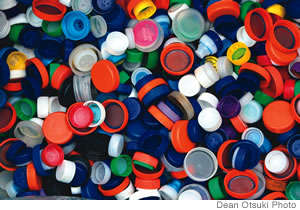How Plastic Bottle Caps Can Kill

Wednesday - May 13, 2009
| Share
 Del.icio.us
Del.icio.us
|
Every day thousands of Hawaii residents innocently do the unthinkable. After twisting the cap off their plastic bottle, many simply lose track of them. It seems harmless enough. How much damage can a cap do?
Truth is, a whole lot. “Like cigarette butts, people toss aside bottle caps because they’re small and seem insignificant,” says Suzanne Frazer, co-founder of Beach Environmental Awareness Campaign Hawaii (B.E.A.C.H.). “Bottle caps are not harmless; they kill.”
Frazer says researchers found 100 percent of Laysan albatross chicks in the Northwestern Hawaiian Islands ingest plastic. She says adult albatross often mistake plastic bottle caps for food. “These bright-colored caps float really easily and the adults think they’re squid or fish eggs,” says Frazer. “They take them back to their chicks that ingest them, and many die from blockage, starvation, dehydration and lacerations.”
B.E.A.C.H. launched a new campaign on Earth Day raising awareness of the impact plastic bottle caps have on marine life. Volunteers say plastic bottle caps are one of the top 10 items found during beach cleanups and are the second most-littered item after cigarette butts.
“In just three events since launching this new campaign we’ve collected more than 2,000 bottle caps,” says Frazer. “It’s going really well and those caps won’t end up in our landfills or harm marine life. It’s an ongoing problem. At one cleanup at Kokololio Beach in 2008, volunteers found 1,232 caps and lids.”
The plastic bottle caps are recycled into new caps and packaging. The new program is groundbreaking. Prior to this campaign there was no organized effort to recycle plastic bottle caps.
“This activity has brought to light what’s recyclable and what’s not,” says Frazer. “A lot of people with blue bins are not sure what to put in them. Many don’t even know why they’re asked to remove caps and lids from the bottles, and when they do, they don’t know what to do with them.”
Frazer recalls a recent incident at Hanauma Bay that highlights the confusion.
“I picked up 20 bottle caps in a just a few minutes then noticed a guy with a bag bulging with plastic bottles,” she recalls. “Turns out he was just throwing caps on the shoreline. People go through garbage cans and take recycled bottles and dropping bottle caps because they know they don’t get money for the caps.”
Frazer says caps are made from a different type of plastic from the bottles and have a different melting point. Any twist-on plastic cap or lid that is made of rigid polypropylene plastic (recycle symbol No. 5) is accepted for recycling, including caps from beverage, shampoo and food product bottles. However, pump, sprayers, plastic lids from margarine containers and any caps that are made of multi layers of plastic resins or metal are not accepted. “In just three events we found more than 3,000 caps, but about 1,000 of them could not be counted,” says Frazer. “It can get confusing, but we’re happy we’re off to a great start and pleased schools are asking how they can help.”
One in particular has gone beyond the call. University Laboratory School has placed a bin on campus for the public to drop off plastic bottle caps anytime.
“I hope other schools will offer collection bins for the public because this is the best way to get this program widespread,” says Frazer. “Aveda also is offering shipping labels for schools so they can easily ship them back to the Mainland for recycling.”
Island residents are making a difference, one plastic bottle cap at a time.
Schools interested in helping to collect bottle caps for recycling can contact B.E.A.C.H. Call 393-2168 for more information or visit www.b-e-a-c-h.org.
E-mail this story | Print this page | Comments (0) | Archive | RSS Comments (0) |
Most Recent Comment(s):













